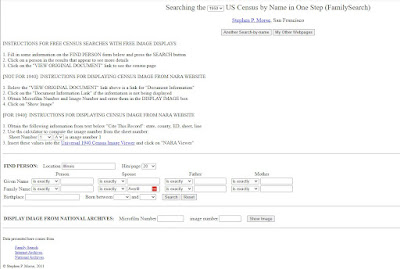Font Size
Showing posts with label Names of People. Show all posts
Showing posts with label Names of People. Show all posts
Find it FAST in the US Census
If you need to look up something in the US Census. Pretty much all the big genealogy sites can help you. However, it takes time to put all the information in and then look through the images. It turns out there are simple and quick ways to look up something in the census.
Person and Place Names Presented in August at NBGS Zoom Meeting
Hello all,
I plan to publish the proceedings of our August meeting as an embedded video, but I'm not there yet. In the meantime, a pdf in Google Docs of the charts may be accessed below.
Persons, Places, Dates and Keeping Things Straight
Early on May 3, 2020, Steve inquired, via email:
"I'm looking for some sage (meaning an opinion other than my own) advice
on ... names. ... Might there be a "Family History Learning Moment" coming up?"
In response, instead of saying "yes, there are many Family History Learning Moments associated with people and place names," Michael Dindinger wrote, on the 3rd of May, 2020 via email, advice on the Names of Persons, Names of Places, and even how Dates work so that people can figure out what is what:
Steve considered this pure gold, so he broke the email down into a four post series, of which this one forms an introduction. Other than the formatting, minimal changes have been made to Michael's thoughts on this important and often misunderstood series of topics, namely how best to record the names of people you are interested in, the places they lived, worked, or visited, and when all the events occurred so that it is understood by future generations. Without futher ado, Heeere's Michael!
"I'm looking for some sage (meaning an opinion other than my own) advice
on ... names. ... Might there be a "Family History Learning Moment" coming up?"
In response, instead of saying "yes, there are many Family History Learning Moments associated with people and place names," Michael Dindinger wrote, on the 3rd of May, 2020 via email, advice on the Names of Persons, Names of Places, and even how Dates work so that people can figure out what is what:
Steve considered this pure gold, so he broke the email down into a four post series, of which this one forms an introduction. Other than the formatting, minimal changes have been made to Michael's thoughts on this important and often misunderstood series of topics, namely how best to record the names of people you are interested in, the places they lived, worked, or visited, and when all the events occurred so that it is understood by future generations. Without futher ado, Heeere's Michael!
Names of People in Genealogical Records
Back to Intro
Names - This Post
Forward to Places
Forward to Dates
 Family History Learning Moment
Family History Learning Moment
by Michael W. Dindinger, via email on 3 May 2020
Names
Names - This Post
Forward to Places
Forward to Dates
 Family History Learning Moment
Family History Learning Momentby Michael W. Dindinger, via email on 3 May 2020
Names
- Six elements make up a name: given name, middle name, surname, title prefix, title suffix plus alternate names. Not all names have all elements. You will want to enter each element in the designated data field.
- A birth name establishes the identity of an individual in a genealogy database. Enter the name given at birth (or baptism) in the language used at the time of the event (e.g., French, German, Latin, etc.) in the given name field.


